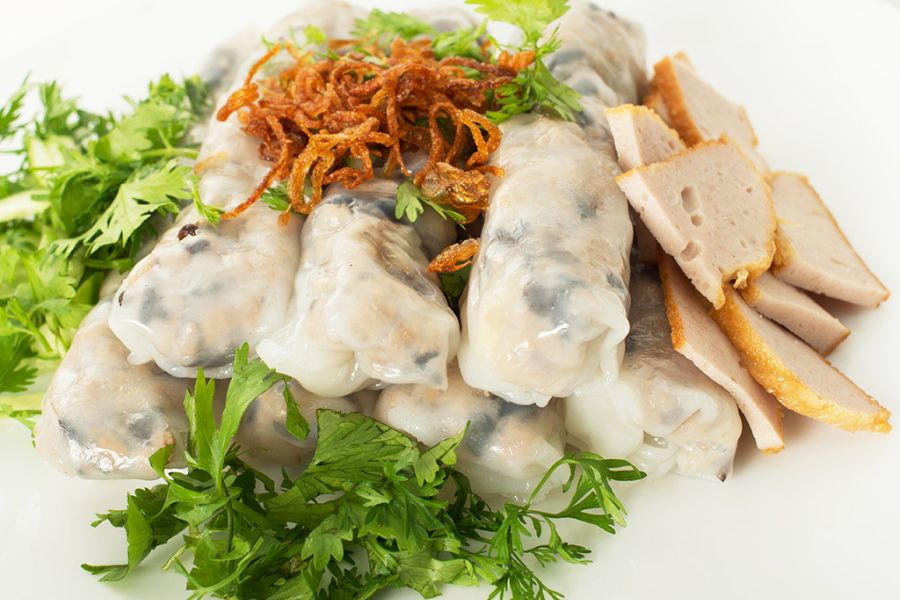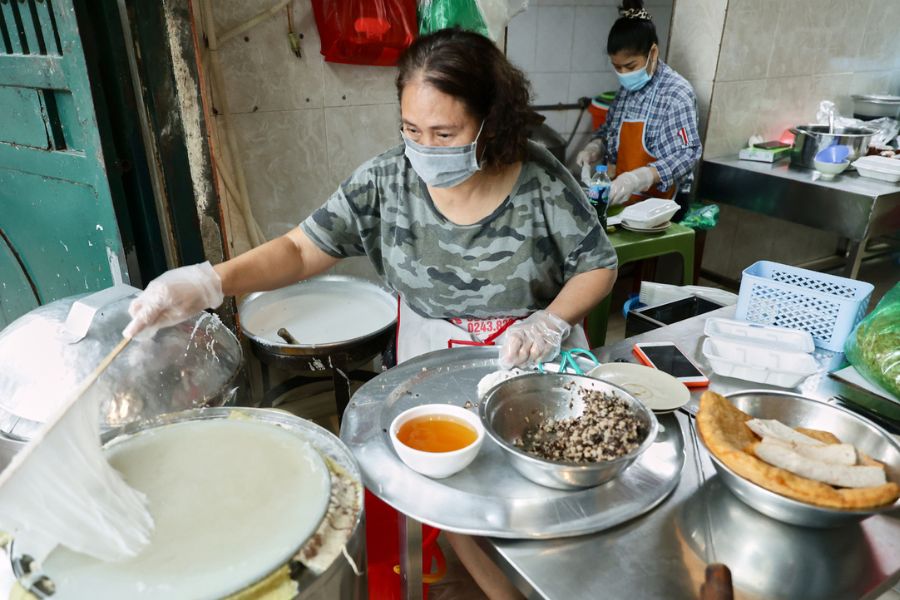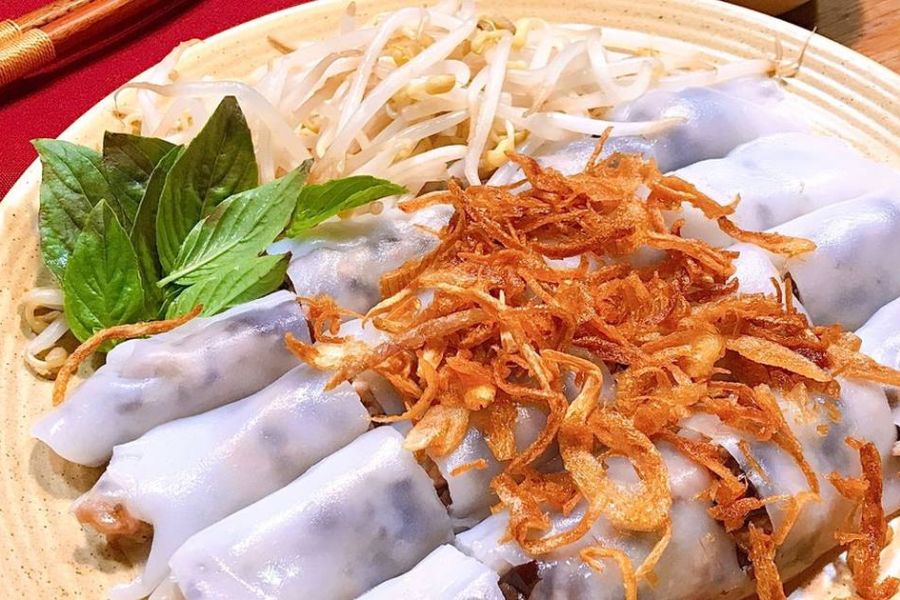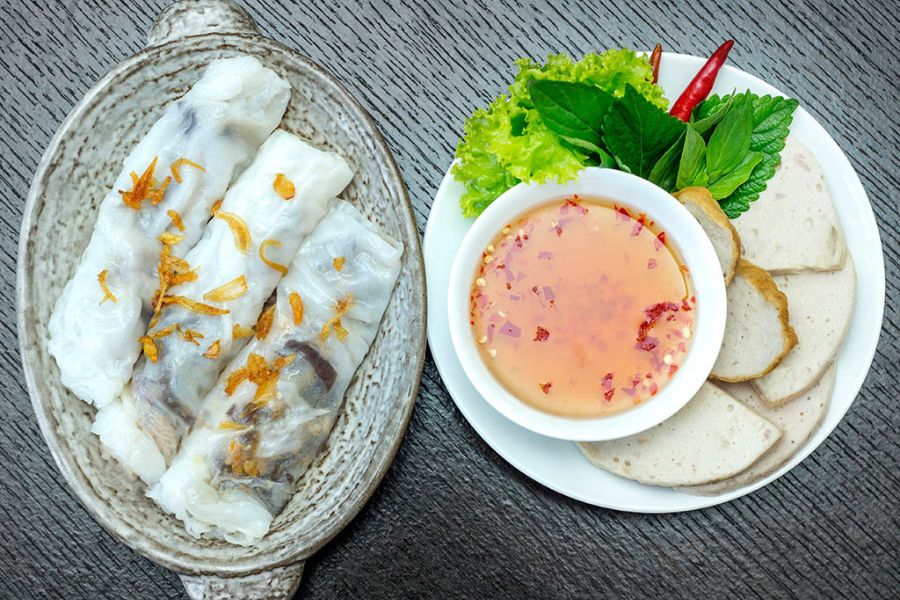Banh cuon, a Vietnamese delicacy, is a beloved dish that exemplifies the rich diversity of Vietnamese cuisine. This steamed rice roll is characterized by its lightness, tastiness, and fulfilling nature. In this article, we will delve into the world of bánh cuốn, exploring its types, regional variations, ingredients, eating culture, and where to savor this delectable treat.
What is Banh Cuon?
Banh Cuon, pronounced “bun kwoon,” is a Vietnamese dish made from a delicate, thin sheet of steamed rice batter. These translucent rice sheets are typically filled with a savory mixture of ingredients such as minced pork, wood ear mushrooms, and shallots. Bánh cuốn is then rolled into a cylindrical shape and served with a variety of accompaniments, including dipping sauces, fresh herbs, and fried shallots.
It is a preferable breakfast dish and a must-try to truly comprehend the diversity of Vietnamese cuisine. Each region leaves a different impression on those who try it, but they all share a rich history and cuisine worth sharing. That’s why we are here, sharing the story of Vietnamese steamed rice rolls with you.
Types of Banh Cuon
Banh Cuon comes in various types, with regional variations offering unique flavors and preparations. Here are the main types:
Banh Cuon in Northern Cities: In the North, especially in Hanoi, Banh Cuon is often served with a mild and clear dipping sauce made from fish sauce and diluted with water. The filling may include ground pork and fragrant dried shrimp. This version is known for its subtlety and simplicity.

Banh Cuon in Central Cities: Central regions, such as Hue, offer a spicier version of Banh Cuon . The dipping sauce tends to be more pungent and can include garlic and chili peppers. The filling might include shrimp, pork, and bean sprouts, adding a burst of flavors to the dish.
Banh Cuon in Southern Cities: Southern areas like Ho Chi Minh City often feature a sweeter and milder dipping sauce. The filling includes a variety of ingredients such as ground pork, prawns, and bean sprouts. Southern bánh cuốn is known for its harmonious blend of sweet, savory, and umami flavors.
Banh Cuon Ingredients
The key ingredients in Banh Cuon include rice batter, ground pork, wood ear mushrooms, shallots, and rice paper. The dipping sauce typically comprises fish sauce, water, sugar, and lime juice. Accompaniments can vary but often consist of fresh herbs like cilantro, mint, and basil, along with fried shallots.

The process of coating the cake is considered one of the most important parts of making banh cuon
Traditionally, it is believed that banh cuon should be made by grounding your own rice and steaming it on a conventional steamer. This process surely requires more time and effort, but it also guarantees the uniqueness of each final product.
Typically, the filling for banh cuon is a mixture of minced pork and wood-ear mushrooms, combined with diced onions and jicama. These vegetables keep the filling moist and flavorful. The mixture is stir-fried and ready to be wrapped in steamed rice sheets.
Banh cuon is commonly served with a variety of Vietnamese cold cuts called cha and nem. These toppings are very common in Vietnamese dishes. A plate of banh cuon typically includes at least three types of cha, such as cha lua (steamed pork sausage), cha chien (fried pork sausage), and cha que (fried cinnamon pork sausage). These Vietnamese sausages have a chewy texture and a slightly fatty taste. Nem, on the other hand, is a type of fermented pork wrapped inside banana leaves. They are little pink cubes seasoned with chilies, garlic, and whole pepper grains.
The dipping sauce is easily made by boiling fish sauce with water and sugar. The sauce is simply balanced between saltiness and sweetness. Minced chilies can be added separately when eating according to personal preference.
The eating culture of banh cuon
- Interestingly, banh cuon is eaten differently between the North and South of Vietnam. In the North, it is common to dip each piece of banh cuon into a small bowl of fish sauce, while in the South, it is more common to pour the fish sauce directly onto the plate. This may be because the dipping sauce in the South is lighter and sweeter.
- There is also a vegetarian version of banh cuon, in which the fillings are made from jicama and wood-ear mushrooms (and possibly other types of mushrooms). The cold cuts are replaced with bean curd sausage and banh tom is substituted with green bean cakes. Of course, the dipping sauce is made with vegan fish sauce.

- Banh cuon is commonly eaten for breakfast because it is light (not oily) and filling. You can customize the toppings to your liking, and most restaurants are happy to remove or add more of your preferred cold cuts.
- Before pouring the dipping sauce onto your banh cuon, make sure to taste it first. The saltiness can vary greatly among restaurants. Consider eating banh tom first while it is still crispy, before it is soaked with the fish sauce.
- When ordering egg steamed rice rolls, be mindful that banh cuon trung means the egg is already mixed with the rice batter, while banh cuon trung long dao (runny egg steamed rice cakes) means the egg yolk is added inside the steaming rice flour sheet and it is then wrapped into a square pillow shape.
- If you are not familiar with raw or fermented meat, it may be a good idea to avoid nem when trying banh cuon for the first time.
Where to Eat Banh Cuon
To savor the authentic flavors of banh cuon, one can visit street food stalls, local restaurants, or specialty Banh Cuon eateries in Vietnam. These establishments offer a wide range of regional variations, allowing you to explore the diverse tastes of this beloved Vietnamese dish.
Steamed rice rolls are always freshly made by order. A plate of banh cuon is still steaming when it is served, which guarantees a delicious and nutritious meal. We hope the information and tips will come in handy for you to experience this favorable local dish. Check out our recommendations below and add the nearby to your to-do list.

Hanoi
- Banh cuon Ba Hoanh
Address: 66 To Hien Thanh, Hoan Kiem District
Price: 25,000 VND – 35,000 VND (~$1 – $1.4) - Banh cuon Ba Xuan
Address: 16 Doc Hoe Nhai, Ba Dinh District
Price: 30,000 VND (~$1.2)
Ho Chi Minh City
- Banh cuon Hong Hanh
Address: 17A Nguyen Thi Minh Khai, District 1
Price: 40,000 VND – 60,000 VND (~$1.6 – $2.5) - Banh cuon Hai Nam
Address: 11A Cao Thang, District 3
Price: 40,000 VND – 45,000 VND (~$1.6 – $1.8)
Banh Cuon is a culinary delight that showcases the artistry of Vietnamese cuisine. With its regional variations, diverse ingredients, and cultural significance, it offers a window into the rich tapestry of Vietnamese culinary traditions. Whether you find yourself in the bustling streets of Hanoi, the historic alleys of Hue, or the vibrant neighborhoods of Ho Chi Minh City, don’t miss the opportunity to savor a plate of bánh cuốn, a true gastronomic treasure.
